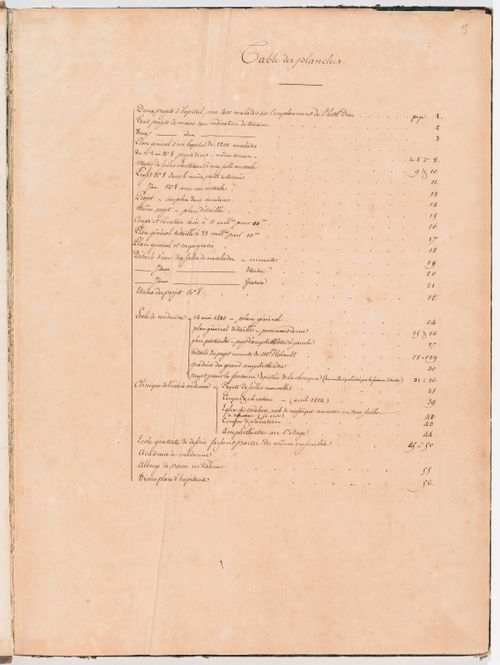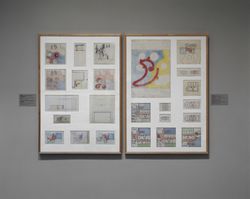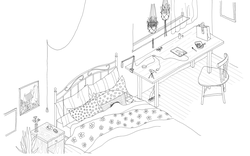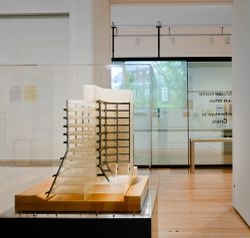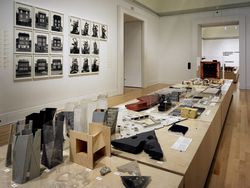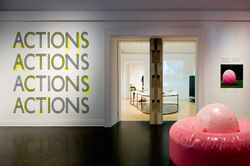documents textuels, photographies
AP197.S2.021
Description:
This box contains mainly chronologies that relate to architectural movements, biographical timelines of architects and the curriculum vitaes of various architects and architecture students. The largest portion of this box consists of research files arranged either by the author's last name or subject for the letter A. A large portion of texts relate to articles about Alvar Aalto and Hannah Arendt.
1965-2016
Chronologies, CVs of others, and research files organized author's last name or subject for the letter A
Actions:
AP197.S2.021
Description:
This box contains mainly chronologies that relate to architectural movements, biographical timelines of architects and the curriculum vitaes of various architects and architecture students. The largest portion of this box consists of research files arranged either by the author's last name or subject for the letter A. A large portion of texts relate to articles about Alvar Aalto and Hannah Arendt.
documents textuels, photographies
1965-2016
Sous-série
AP151.S1.D10
Description:
The project files documenting the construction of the Wayfarers' Chapel and site are extensive and quite complete. The documentation is more complete for the first two units of construction than for the latter units. Thus, the internal coherence of the papers is more apparent for the earlier development of the project. The most comprehensive record of the development of the Wayfarers' Chapel is contained in the "Supervision Journal" which covers the period from 1947-1971 (files 97a/97b of the "General Files"). It should be noted particularly by researchers using these papers. The research value of the "Supervision Journal" is complemented by a substantial body of general correspondence which documents Lloyd Wright's interaction with the client and with other parties involved with the design or construction of the Chapel (the Palos Verdes Corporation, the Wayfarers Chapel Building and Properties Committee, and Reverends of the Chapel between 1947 and 1960). Further correspondence relates to the publicity for the Chapel between 1951 and 1965. The textual documents are augmented by an extensive array of visual materials, such as drawings, photographs, postcards, newspaper articles and trade catalogues, which are valuable for providing a pictorial record of the Chapel and site from its earliest through to its later development. The "Trade Catalogues and Supplier Ephemera" file (file 98 of the "General Files") contains a record of the products and supplies Lloyd Wright considered or used in the construction of the Wayfarers' Chapel.
1946-1977
Wayfarers' Chapel Architect's Project Files
Actions:
AP151.S1.D10
Description:
The project files documenting the construction of the Wayfarers' Chapel and site are extensive and quite complete. The documentation is more complete for the first two units of construction than for the latter units. Thus, the internal coherence of the papers is more apparent for the earlier development of the project. The most comprehensive record of the development of the Wayfarers' Chapel is contained in the "Supervision Journal" which covers the period from 1947-1971 (files 97a/97b of the "General Files"). It should be noted particularly by researchers using these papers. The research value of the "Supervision Journal" is complemented by a substantial body of general correspondence which documents Lloyd Wright's interaction with the client and with other parties involved with the design or construction of the Chapel (the Palos Verdes Corporation, the Wayfarers Chapel Building and Properties Committee, and Reverends of the Chapel between 1947 and 1960). Further correspondence relates to the publicity for the Chapel between 1951 and 1965. The textual documents are augmented by an extensive array of visual materials, such as drawings, photographs, postcards, newspaper articles and trade catalogues, which are valuable for providing a pictorial record of the Chapel and site from its earliest through to its later development. The "Trade Catalogues and Supplier Ephemera" file (file 98 of the "General Files") contains a record of the products and supplies Lloyd Wright considered or used in the construction of the Wayfarers' Chapel.
Subseries
1946-1977
DR1974:0002:008:001-077
Description:
- This album contains prints and drawings - primarily design development and presentation drawings - mainly for projects for ideal hospitals and for the unexecuted redevelopment of the École de médecine and the surrounding area in Paris by Hubert Rohault de Fleury. Projects for ideal hospitals include: two block plans for hospitals for 400 patients on the site of Hôtel-Dieu (DR1974:0002:008:002 - DR1974:0002:008:003); nine site plans coloured with wash for hospitals for varying numbers of patients, eight of which are for a site near the barrière de Monceau (DR1974:0002:008:010 - DR1974:0002:008:014 and DR1974:0002:008:017 - DR1974:0002:008:020); five block plans for hospitals with no site indicated (DR1974:0002:008:004 - DR1974:0002:008:008); and plans, sections and elevations, most coloured with wash or watercolour, for a more developed project for an ideal hospital for 1000 to 1200 patients with no site indicated (DR1974:0002:008:022 - DR1974:0002:008:025, DR1974:0002:008:027 - DR1974:0002:008:028). The five other drawings for hospitals included in this album are apparently related to the nine site plans (DR1974:0002:008:015, DR1974:0002:008:016, DR1974:0002:008:021, DR1974:0002:008:029, and DR1974:0002:008:030). Plans, elevations and sections for the redevelopment of the area surrounding the École de médecine include the addition of a second amphitheatre to the École de médecine, an addition to the Clinique de l'École de médecine, the alteration of the École de mosaïque for use as a salle de dissection, and alterations to the École royale gratuite de dessin (DR1974:0002:008:031 - DR1974:0002:008:064). Also included are several designs for a classically-inspired fountain to be located at the entrance to the Clinique de l'École de médecine (DR1974:0002:008:042 - DR1974:0002:008:049), and drawings for the Académie de médecine, an institution which was probably housed at the École de médecine during this period (DR1974:0002:008:065 - DR1974:0002:008:068). The album includes record drawings of medical buildings by other architects: a presentation drawing of the Albergo dei poveri in Palermo, designed by Orazio Foretto Palermitano; tracings from drawings of a project for Hôtel-Dieu in Paris, designed by Charles-François Viel de Saint-Maux; the 1775 Grand Prix project for an École de médecine designed by Paul Guillaume Lemoine; prints of the the Hospice de la charité in Lyon, designed by Jean Pollet, and two hospital projects in Dijon designed by Paul P. Petit (DR1974:0002:008:069 - DR1974:0002:008:077).
architecture, topographique
first half of the 19th century
Album of drawings and prints for ideal hospitals, drawings for the redevelopment of the École de médecine and the surrounding area, Paris, and record drawings of medical buildings by French and Italian architects
Actions:
DR1974:0002:008:001-077
Description:
- This album contains prints and drawings - primarily design development and presentation drawings - mainly for projects for ideal hospitals and for the unexecuted redevelopment of the École de médecine and the surrounding area in Paris by Hubert Rohault de Fleury. Projects for ideal hospitals include: two block plans for hospitals for 400 patients on the site of Hôtel-Dieu (DR1974:0002:008:002 - DR1974:0002:008:003); nine site plans coloured with wash for hospitals for varying numbers of patients, eight of which are for a site near the barrière de Monceau (DR1974:0002:008:010 - DR1974:0002:008:014 and DR1974:0002:008:017 - DR1974:0002:008:020); five block plans for hospitals with no site indicated (DR1974:0002:008:004 - DR1974:0002:008:008); and plans, sections and elevations, most coloured with wash or watercolour, for a more developed project for an ideal hospital for 1000 to 1200 patients with no site indicated (DR1974:0002:008:022 - DR1974:0002:008:025, DR1974:0002:008:027 - DR1974:0002:008:028). The five other drawings for hospitals included in this album are apparently related to the nine site plans (DR1974:0002:008:015, DR1974:0002:008:016, DR1974:0002:008:021, DR1974:0002:008:029, and DR1974:0002:008:030). Plans, elevations and sections for the redevelopment of the area surrounding the École de médecine include the addition of a second amphitheatre to the École de médecine, an addition to the Clinique de l'École de médecine, the alteration of the École de mosaïque for use as a salle de dissection, and alterations to the École royale gratuite de dessin (DR1974:0002:008:031 - DR1974:0002:008:064). Also included are several designs for a classically-inspired fountain to be located at the entrance to the Clinique de l'École de médecine (DR1974:0002:008:042 - DR1974:0002:008:049), and drawings for the Académie de médecine, an institution which was probably housed at the École de médecine during this period (DR1974:0002:008:065 - DR1974:0002:008:068). The album includes record drawings of medical buildings by other architects: a presentation drawing of the Albergo dei poveri in Palermo, designed by Orazio Foretto Palermitano; tracings from drawings of a project for Hôtel-Dieu in Paris, designed by Charles-François Viel de Saint-Maux; the 1775 Grand Prix project for an École de médecine designed by Paul Guillaume Lemoine; prints of the the Hospice de la charité in Lyon, designed by Jean Pollet, and two hospital projects in Dijon designed by Paul P. Petit (DR1974:0002:008:069 - DR1974:0002:008:077).
architecture, topographique
documents textuels
AP197.S2.040
Description:
The box consists of essays, articles, publications and clippings writtin by others that relate to architecture and various architects. Architects and subjects explored include: Vittorio Gregotti; August Perret; James Stirling; Alison and Peter Smithson; Soviet architecture; Louis Kahn; and David Chipperfield.
circa 1965-2010
Unsorted essays, articles, publications, images and clippings about architecure, various architects and related subjects
Actions:
AP197.S2.040
Description:
The box consists of essays, articles, publications and clippings writtin by others that relate to architecture and various architects. Architects and subjects explored include: Vittorio Gregotti; August Perret; James Stirling; Alison and Peter Smithson; Soviet architecture; Louis Kahn; and David Chipperfield.
documents textuels
circa 1965-2010
articles
Réinitialiser le social
Soirée, famille, Quoi si ce n’est pas la famille?, Miranda July, Other Architects, Grace Mortlock, David Neustein, Elena Schütz, Julian Schubert, Leonard Streich, Something Fantastic, Edit Collective, Marisa Morán Jahn, Rafi Segal, Carehaus, Johanna Hurme, 5468796 Architecture, Nahira Gerster-Sim, Frida Escobedo, Kumiko Inui, Emanuel Admasu, AD-WO
7 juin 2021
Quoi, si ce n’est pas la famille?
Des invités d'horizons multidisciplinaires discutent des implications spatiales liées à la transformation continue des idées sur la famille
Actions:
Réinitialiser le social
Paul Nelson (1895-1979), architecte, décorateur de cinéma, peintre, critique et professeur, a enseigné et pratiqué l’architecture aux États-Unis et en France pendant plus de cinquante ans. Dans les années 30 et 40, Nelson a été l’une des figures de proue du fonctionnalisme, ce mouvement qui a rejeté le langage Beaux-Arts au profit de l’expression fonctionnelle et(...)
Salles principales
27 mars 1991 au 26 mai 1991
Le crible de la raison : l’oeuvre de Paul Nelson
Actions:
Description:
Paul Nelson (1895-1979), architecte, décorateur de cinéma, peintre, critique et professeur, a enseigné et pratiqué l’architecture aux États-Unis et en France pendant plus de cinquante ans. Dans les années 30 et 40, Nelson a été l’une des figures de proue du fonctionnalisme, ce mouvement qui a rejeté le langage Beaux-Arts au profit de l’expression fonctionnelle et(...)
Salles principales
articles
La vie à l’ère du précariat phymérique : Quelques termes nouvellement inventés comme introduction aux réalités contemporaines.
Texte de Isaac Harrisson, Grace Mortlock, Lindsay Mulligan et David Neustein, Other Architects. Illustrations d’Isaac Harrisson.
Actions:
articles
31 mai 2021
Réinitialiser le social
Les influences radicalement divergentes qui ont marqué l’architecte James Frazer Stirling rendent impossibles la caractérisation de son œuvre, qualifiée par d’autres comme étant moderniste d’avant-guerre, néoclassique, rationaliste, brutaliste, postmoderniste. Mais la continuité de sa pensée émerge de l’impressionnante quantité et diversité de documents conservés dans les(...)
Salles principales
16 mai 2012 au 14 octobre 2012
Notes d’archives : James Frazer Stirling
Actions:
Description:
Les influences radicalement divergentes qui ont marqué l’architecte James Frazer Stirling rendent impossibles la caractérisation de son œuvre, qualifiée par d’autres comme étant moderniste d’avant-guerre, néoclassique, rationaliste, brutaliste, postmoderniste. Mais la continuité de sa pensée émerge de l’impressionnante quantité et diversité de documents conservés dans les(...)
Salles principales
Herzog de Meuron: archéologie de l’imaginaire présente un éventail exhaustif de documents provenant des archives des architectes Herzog de Meuron et de collections connexes. À l’image d’une exposition d’histoire naturelle, celle-ci comprend maquettes d’étude, livres, photographies, jouets, photographies, fossiles, pierres de lettrés chinois ainsi que quelques œuvres(...)
Salles principales
23 octobre 2002 au 6 avril 2003
Herzog & de Meuron : archéologie de l'imaginaire
Actions:
Description:
Herzog de Meuron: archéologie de l’imaginaire présente un éventail exhaustif de documents provenant des archives des architectes Herzog de Meuron et de collections connexes. À l’image d’une exposition d’histoire naturelle, celle-ci comprend maquettes d’étude, livres, photographies, jouets, photographies, fossiles, pierres de lettrés chinois ainsi que quelques œuvres(...)
Salles principales
Des architectes, des artistes et des collectifs en provenance de plusieurs pays redéfinissent des activités en apparence anodines comme le jardinage, le recyclage, le jeu ou la marche. Confrontées aux normes de comportement urbain communément admises, leurs actions vont parfois jusqu’à défier les prescriptions de la loi. Les groupes ou les individus mis en scène dans(...)
Salles principales
26 novembre 2008 au 19 avril 2009
Actions : comment s’approprier la ville
Actions:
Description:
Des architectes, des artistes et des collectifs en provenance de plusieurs pays redéfinissent des activités en apparence anodines comme le jardinage, le recyclage, le jeu ou la marche. Confrontées aux normes de comportement urbain communément admises, leurs actions vont parfois jusqu’à défier les prescriptions de la loi. Les groupes ou les individus mis en scène dans(...)
Salles principales
